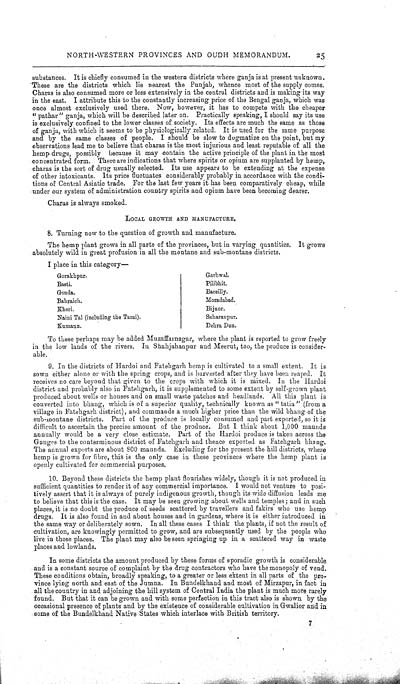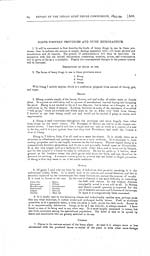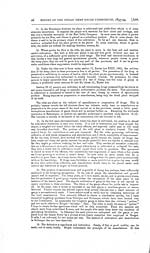Medicine - Drugs > Report of the Indian Hemp Drugs Commission, 1894-1895 > Volume III
(29) Volume 3, Page 25
Thumbnail gallery: Grid view | List view

NORTH-WESTERN PROVINCES AND OUDH MEMORANDUM. 25
substances. It is chiefly
consumed in the western districts where ganja is at present
unknown.
These are the districts which lie nearest the Punjab, whence most
of the supply comes.
Charas is also consumed more or less extensively in the central
districts and is making its way
in the east. I attribute this to the constantly increasing price of
the Bengal ganja, which was
once almost exclusively used there. Now, however, it has to compete
with the cheaper
"pathar" ganja, which will be described later on. Practically
speaking, I should say its use
is exclusively confined to the lower classes of society. Its
effects are much the same as those
of ganja, with which it seems to be physiologically related. It is
used for the same purpose
and by the same classes of people. I should be slow to dogmatize on
the point, but my
observations lead me to believe that charas is the most injurious
and least reputable of all the
hemp drugs, possibly because it may contain the active principle of
the plant in the most
concentrated form. There are indications that where spirits or
opium are supplanted by hemp,
charas is the sort of drug usually selected. Its use appears to be
extending at the expense
of other intoxicants. Its price fluctuates considerably probably in
accordance with the condi-
tions of Central Asiatic trade. For the last few years it has been
comparatively cheap, while
under our system of administration country spirits and opium have
been becoming dearer.
Charas is always smoked.
LOCAL GROWTH AND MANUFACTURE.
8. Turning now to the question of growth and manufacture.
The hemp plant grows in
all parts of the provinces, but in varying quantities. It
grows
absolutely wild in great profusion in all the montane and
sub-montane districts.
|
I place in this category— |
|
|
Gorakhpur. |
Garhwal. |
|
Basti. |
Pilibhit. |
|
Gonda. |
Bareilly. |
|
Bahraich. |
Moradabad. |
|
Kheri. |
Bijnor. |
|
Naini Tal (including the Tarai). |
Saharanpur. |
|
Kumaun. |
Dehra Dun. |
To these perhaps may be
added Muzaffarnagar, where the plant is reported to grow
freely
in the low lands of the rivers. In Shahjahanpur and Meerut, too,
the produce is consider-
able.
9. In the
districts of Hardoi and Fatehgarh hemp is cultivated to a small
extent. It is
sown either alone or with the spring crops, and is harvested after
they have been reaped. It
receives no care beyond that given to the crops with which it is
mixed. In the Hardoi
district and probably also in Fatehgarh, it is supplemented to some
extent by self-grown plant
produced about wells or houses and on small waste patches and
headlands. All this plant is
converted into bhang, which is of a superior quality, technically
known as "tatia" (from a
village in Fatehgarh district), and commands a much higher price
than the wild bhang of the
sub-montane districts. Part of the produce is locally consumed and
part exported, so it is
difficult to ascertain the precise amount of the produce. But I
think about 1,000 maunds
annually would be a very close estimate. Part of the Hardoi produce
is taken across the
Ganges to the conterminous district of Fatehgarh and thence
exported as Fatehgarh bhang.
The annual exports are about 800 maunds. Excluding for the present
the hill districts, where
hemp is grown for fibre, this is the only case in these provinces
where the hemp plant is
openly cultivated for commercial purposes.
10. Beyond
these districts the hemp plant flourishes widely, though it is not
produced in
sufficient quantities to render it of any commercial importance. I
would not venture to posi-
tively assert that it is always of purely indigenous growth, though
its wide diffusion leads me
to believe that this is the case. It may be seen growing about
wells and temples; and in such
places, it is no doubt the produce of seeds scattered by travellers
and fakirs who use hemp
drugs. It is also found in and about houses and in gardens, where
it is either introduced in
the same way or deliberately sown. In all these cases I think the
plants, if not the result of
cultivation, are knowingly permitted to grow, and are subsequently
used by the people who
live in those places. The plant may also be seen springing up in a
scattered way in waste
places and lowlands.
In some districts the
amount produced by these forms of sporadic growth is
considerable
and is a constant source of complaint by the drug contractors who
have the monopoly of vend.
These conditions obtain, broadly speaking, to a greater or less
extent in all parts of the pro-
vince lying north and east of the Jumna. In Bundelkhand and most of
Mirzapur, in fact in
all the country in and adjoining the hill system of Central India
the plant is much more rarely
found. But that it can be grown and with some perfection in this
tract also is shown by the
occasional presence of plants and by the existence of considerable
cultivation in Gwalior and in
some of the Bundelkhand Native States which interlace with British
territory.
7
Set display mode to: Large image | Zoom image | Transcription
Images and transcriptions on this page, including medium image downloads, may be used under the Creative Commons Attribution 4.0 International Licence unless otherwise stated. ![]()
| India Papers > Medicine - Drugs > Report of the Indian Hemp Drugs Commission, 1894-1895 > Volume III > (29) Volume 3, Page 25 |
|---|
| Permanent URL | https://digital.nls.uk/74551768 |
|---|---|
| Description | North-Western Provinces and Oudh memorandum, cont. |
| Description | Volume 3: Appendices. Miscellaneous. |
|---|---|
| Attribution and copyright: |
|




